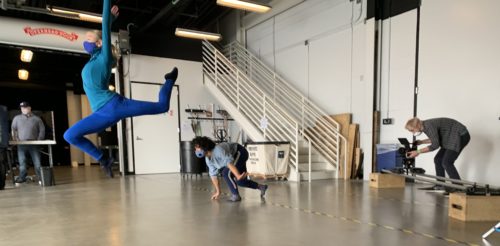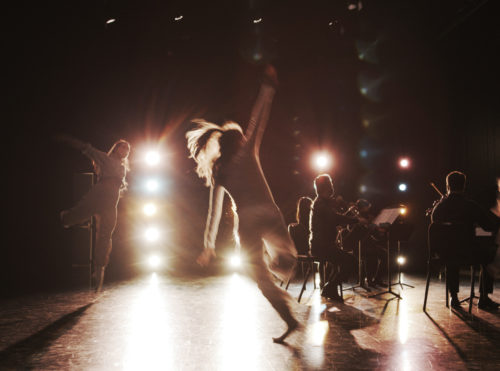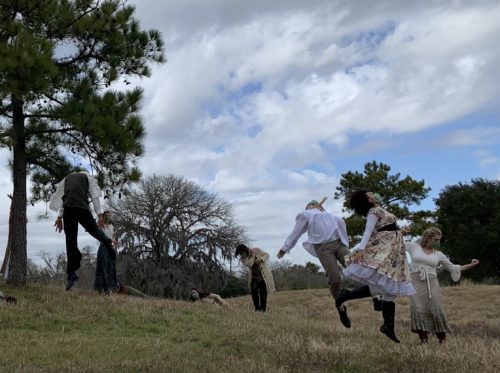Collaboration in a Time of Crisis
Musiqa and Open Dance Project Present Second Collaboration, Inside/Out
 Inside/Out is a program of two dance-for-film pieces, a collaboration between Houston’s “music collective,” Musiqa, contemporary dance company, Open Dance Project, and film artist James Templeton. The first film, “Moving Pieces,” is set in and around the Midtown Art and Theater Center Houston (MATCH) (“inside”). The second film, “Still We Tend,” was filmed in the recently opened Houston Botanic Garden (“out”).
Inside/Out is a program of two dance-for-film pieces, a collaboration between Houston’s “music collective,” Musiqa, contemporary dance company, Open Dance Project, and film artist James Templeton. The first film, “Moving Pieces,” is set in and around the Midtown Art and Theater Center Houston (MATCH) (“inside”). The second film, “Still We Tend,” was filmed in the recently opened Houston Botanic Garden (“out”).
That’s the simple description of the evening. There’s a lot more going on.
Open Dance Project had been working on their movement when ODP’s artistic director Annie Arnoult scouted out the locations with James. The music for “Moving Pieces” is “An Index of Particular Strokes” by composer Andrew Norman. Within it is a collection of nine shorter movements with titles like “skip,” “skim,” “release,” and “scrape.” The sounds of the movements vary in texture, from more traditional contemporary composition to strident, discordant sounds. Annie and James set these movements in specific sites throughout the MATCH, from the back loading dock to the front lobby and breezeway with several stops in between. Annie went back to her company of choreographers and handed out the assignments. You’re in the hallway. You’re in the dressing room. You’re on the stage. You’re in the audience. Etc.
Which is to say the setting of the movements were Annie’s concept, but she was not the choreographer. She had assigned members of ODP to choreograph each movement, and they, in turn, worked with members of their youth ensemble, ODP2, giving the student members a chance to create and perform with the professional dancers. “This was some real serious dancing to some challenging music,” Annie said. “Here, you’ve got a duet and it’s 40 seconds long and it matters. And those kids got it!” Annie grows more animated as she describes one particular moment in the MATCH breezeway, where a youth member drags a chair across the concrete floor. “I’m proud of those kids! I’m proud that they get it, that scraping a chair is dancing!”
 Dr. Anthony Brandt, the artistic director of Musiqa, described his experience of watching the movement in the spaces transformed by the camera and editing of James. Dr. Brandt was in the space, watching the dancers as the filming took place. “When the filming is happening, you’re seeing the totality of all the movement and then the film turns it into a different kind of dance,” he said. He describes one section, “down,” which took place in the audience of the theater. “I watched that sitting in the theater from the side, and it was a totally different ballet watching it from the bottom of the stairs.”
Dr. Anthony Brandt, the artistic director of Musiqa, described his experience of watching the movement in the spaces transformed by the camera and editing of James. Dr. Brandt was in the space, watching the dancers as the filming took place. “When the filming is happening, you’re seeing the totality of all the movement and then the film turns it into a different kind of dance,” he said. He describes one section, “down,” which took place in the audience of the theater. “I watched that sitting in the theater from the side, and it was a totally different ballet watching it from the bottom of the stairs.”
Annie gives credit for this sort of transformation to the filmmaker. “The angles and the framing of the shots was James.”
This collaboration started with the music—indeed, the credits on the films states that these projects were commissioned by Musiqa. In this case, Dr. Brandt presented Annie with some pieces of music. Annie replied with which ones she wanted to work with. And then, for the most part, they went their separate ways as Musiqa rehearsed and recorded the music and ODP headed to their studios to choregraph and rehearse. “I love the autonomy in the collaboration,” notes Dr. Brandt. “We each occupy our side and then meet in the middle.”
In the case of creating film, one site of the “middle” is before the camera. While the dancers are most obvious, the musicians are also in the frame. In “Moving Pieces,” the members of Musiqa are seen in the stage section with their instruments out and playing them, but then in other sections they simply pass through or else stand browsing the vending machines outside the MATCH dressing rooms.
The musicians are more active in “Still We Tend.” The music, “Tegere Tulon” by Hawa Kassé Mady Diabaté, includes hand claps in varying rhythms and the musicians, in their concert black clothes, are seen clapping along—but that’s not all. They also walk through the dancers and occasionally employ the “choreography” of their muscle memory, miming their instruments (which could not be safely played outdoors). All these were directions given by Annie on the day of the shoot and the musicians took to it to Annie’s obvious delight. “It is so much better than I could have choreographed!”
 Dr. Brandt, added “I give the musicians a lot of credit because you see their raw performance persona. Obviously when they’re performing the actual music, you’re very much connected to them through what they’re playing, but in the dance, you can see how theatrical they are just as a presence.”
Dr. Brandt, added “I give the musicians a lot of credit because you see their raw performance persona. Obviously when they’re performing the actual music, you’re very much connected to them through what they’re playing, but in the dance, you can see how theatrical they are just as a presence.”
I bring up the musician’s black clothing because the costuming in “Still We Tend” is of note. The film was shot on a January day and the backdrop is the particular Texas winter mix of greys and browns of faded summer grasses and barren trees but also the dark and bright greens of succulents, palms, evergreens, and winter grasses. The dancers’ clothing complements this background, often picking up the natural hues and textures. I asked Annie who did the costumes. “We did, it’s pulled from stock,” she said, “We didn’t have a costume budget.” The dancers all sorted through clothes on hand, trying things on, giving a piece to a cast-mate, receiving another piece. “I did pull very consciously, having spent a lot of time in the garden, and knowing ‘this is where we’re going to shoot, we’re going to be in these rocks.’” The contrast of the musicians standing out against the landscape with the dancers complementing the land is, to briefly put on the reviewer’s hat, very effective for creating and sustaining a mood.
And speaking of budgets, the films were each filmed in one day, two days consecutive. The spaces, both the theater and the garden, were rented, as was some of the equipment used. “It was two ten-hour days,” Annie emphasized. “Those dancers danced 10 hours. Over and over and over again.”
“They were clearly having a wonderful time, they had a great esprit de corps “Dr. Brandt adds, “but yeah, it was a workout.”
Inside/Out is the second collaboration between Musiqa and ODP. The artistic directors didn’t know each other before Houston’s premiere arts journalist, Nancy Wozny introduced them to each other. Now they joke they are “crisis collaborators.” Their first shared show took place while Hurricane Harvey bore down on Houston and now their second shared project is taking place during a global pandemic. These crises do not seem to dampen their enthusiasm for the relationship they’ve built. Without specific plans at the moment, they appear enthusiastic to do it again sometime.
And about that global pandemic—the films are not exactly about it, but its presence is felt. They had decisions to make about their safety. The musicians and dancers perform throughout the films in masks. “Yes, this is going to time stamp this and everyone is going to know forever that we did it during the time of the pandemic,” Dr. Brandt conceded, “but it also shows we did work during the pandemic and it’s very hopeful in that sense.”
The films are available for viewing online between 10am and 10pm, Central Time on February 27 and 28. For ticket and access information, visit musiqahouston.org.



Recent Comments